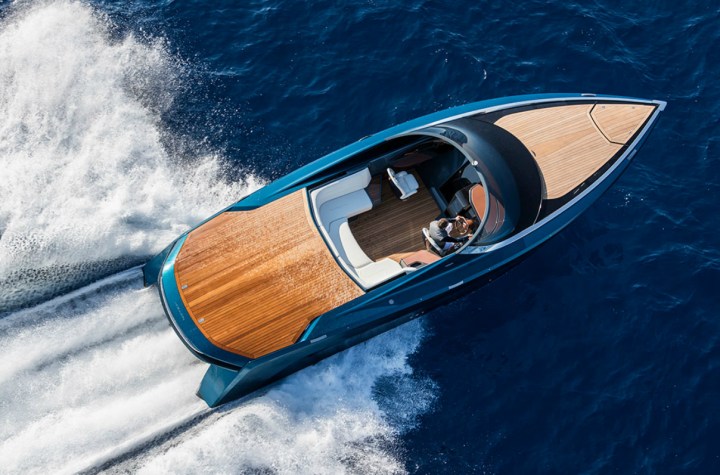
The brand that is irrevocably linked to the James Bond franchise just can’t introduce anything stodgy or sedate. Aston Martin worked with naval architect Mulder Design and partnered with Quintessence Yachts to suss out the fine details and actually build the AM37.
Here’s how the Quintessence website introduces the AM37: “Every once in a while, something radically different from the norm is introduced to the world which alters people’s perceptions. In the powerboat industry, this game-changing moment has now arrived as earth meets water in the most spectacular way imaginable. For many years, those who love driving on both land and water have wondered how it might feel to own a boat that would match the ‘Power, Beauty and Soul’ of their Aston Martin car. Their wish – your wish – has now been fulfilled….Your life may never be quite the same again… .”
So what’s the makeup of this new “earth meets water” vessel? First off, there are two versions of the 37-foot powerboat, the AM37 and the AM37S. The AM37, with an estimated top speed of 45 knots, comes with your choice of two 370hp Mercury diesel or two 430hp Mercury gas engines. The AM37S has an estimated maximum speed of 50 knots from twin 520hp Mercury gas engines.
It’s not just a speedboat, but a day cruiser. You can convert the table in the cockpit into a bed. By repositioning three lightweight carbon panels electrohydraulically, the open cockpit becomes an enclosed, luxurious, comfy space complete with air conditioning and mood lighting. If this rig doesn’t show up at the end of the next Bond movie, people may wonder why not.
There’s a lavatory on board along with a refrigerator, microwave oven, and coffee machine. For daytime use, a carbon-fiber bimini top slides up electrohydraulically and a swim platform extends from the aft deck.
The dashboard has design elements from Aston Martin cars, with navigation, control, and entertainment systems integrated. The steering wheel, throttle handles, and joystick are made of polished metals.
Marek Reichman, Aston Martin’s executive vice president and chief creative officer, sums up the new watercraft: “M37 is a pure translation of the Aston Martin DNA into an entirely new maritime concept. The powerboat reflects our values in terms of power, beauty, and soul. The most important attribute for Aston Martin is the design language and proportion — we have transferred this DNA into AM37. It was important to us when considering this project to make sure that the boat design was as beautiful and timeless as our cars. The AM37 is a striking boat with fantastic proportion and elegance.”



